Great, so you just shot a deer! Now the real work starts. Maybe you have been running trail cameras all season and really going hard scouting and looking for a particular buck, or maybe you just walked out to a tried and true stand for the first time this year and found a deer you wanted to take home. Either way, that was the easy part. Now it is time to process your deer, and you need to do it as quickly as possible.
Processing a deer from field to table can take a while, and it is fine to take your time after you get your deer cooled down. Although if you want your deer to taste as good as possible, you need to get it into the cooler as soon as you can.
You will definitely be able to taste the difference between a deer that was cleaned within the hour, and one that wasn’t cleaned until the next day. Since you are reading this, it is safe to assume you want your deer to be as good as it can be. So let’s dive a little deeper into how much time you really have to get that deer in the cooler and answer a few more of your burning questions.
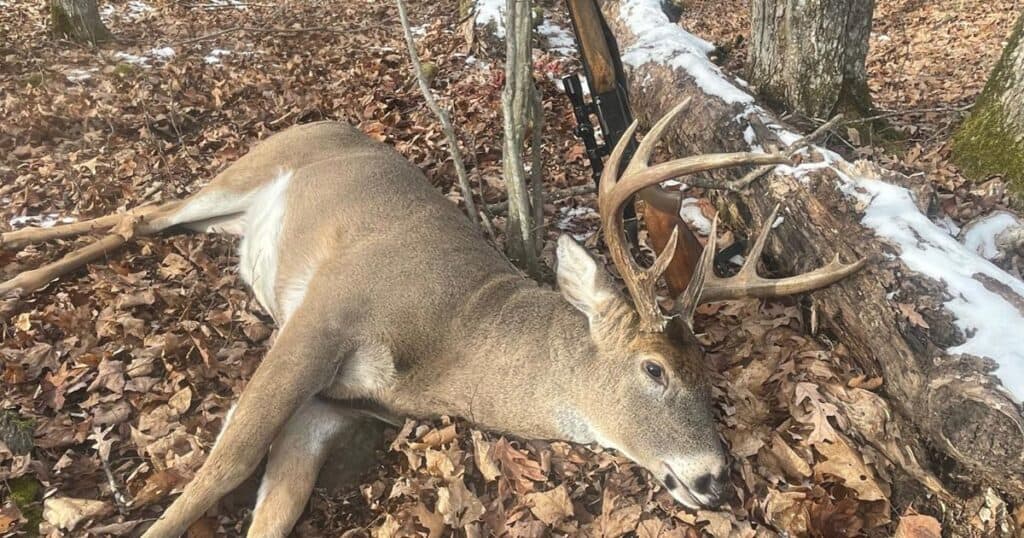
Gut Your Deer ASAP
This is something that bugs me a little bit… If you have already recovered your deer, START CLEANING. Sure, you can take a few moments to take some pictures and have a good time, but finding the deer is the only thing that should stand in the way of gutting.
It kills me every time I see a hunting show that has a few guys hunting and they all manage to shoot deer many hours or even a day apart, and the show ends with a big picture of all the guys and their deer that have not even been field dressed. That just shows they never really planned on eating it, and it is just all about the show. It also teaches some hunters that they don’t need to hurry processing their deer, and then they wonder why their deer taste so bad.
If you didn’t bring your cooler with you, you can’t go with the gutless method. The gutless method is simply just quartering your deer out and putting it on ice without gutting it at all, and that is my go-to method if I brought a cooler. Although when I am hunting close to home, I don’t bother with the cooler and ice. So I gut it before taking it home to quarter and put on ice.
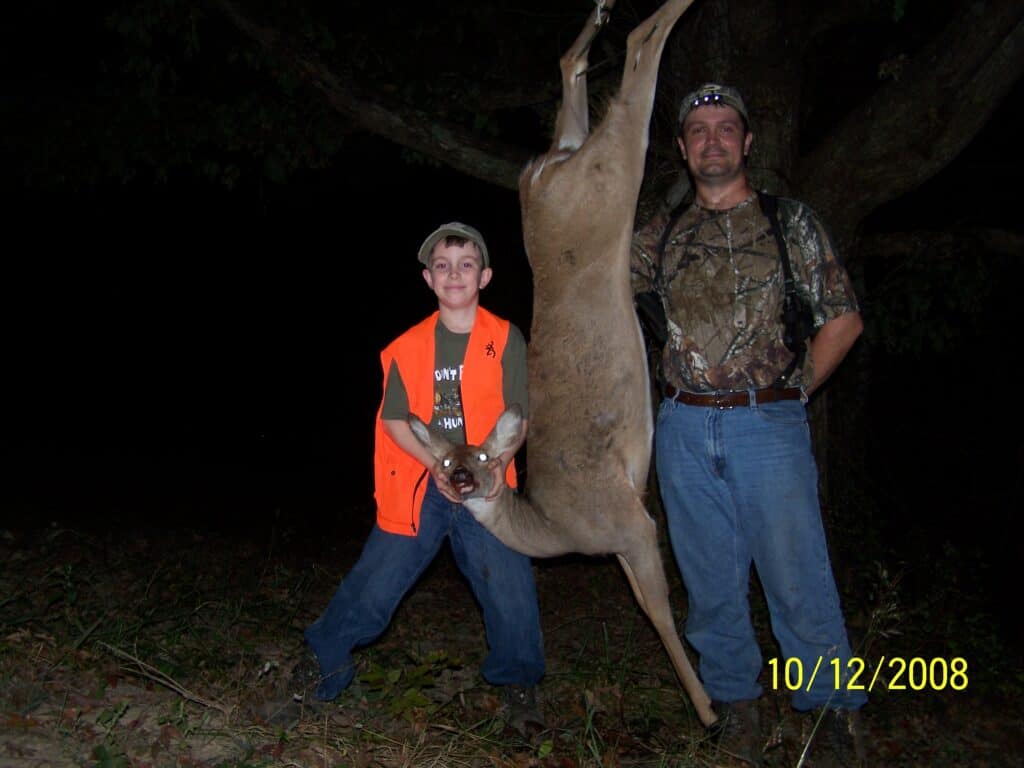
If you can’t put the quarters straight on ice, you need to gut your deer. This is also called field dressing. The organs contain a large amount of bacteria that you do not want to seep into your meat, and if you managed to hit the digestive tract, it is even more important to get that out of your deer.
Excess bacteria growth and any kind of matter that comes out of the organs is the number one thing that can taint the taste of your meat, and increase how fast it spoils. Cleanly gutting your deer totally removes the possibility of that matter contacting your edible meat, and greatly reduces the amount of bacteria present in the carcass.
New Hunters Should Gut Deer Too
Even if you don’t want to fully process your deer yourself, gutting it before you take it to the processor will not only make your deer taste better, but it will save you a few bucks too. I don’t know about your processor, but my local processor charges $45 to gut a deer. I totally understand a new hunter taking their entire deer to a processor, and that is fine. Although after your first one, pull out that knife and start digging around.
You could honestly do more harm than good if you puncture the wrong organ or the bladder, but it is nothing we haven’t all done before and learning how to do it yourself makes you that much of a better hunter. Plus, it is the first step in being able to take a deer from the woods to the dinner table by yourself, which is a major achievement for any outdoorsman.
Did You Know I Had a Newsletter?! 📬
I do! I send out a weekly email that talks all about deer hunting and is a bit more personal than a regular article. If you sign up right now, I will even send you the first chapter of my Ebook “The Hunters Guide to Scent Control” for free! What is there to lose? 🙂
The Main Factor: Temperature
If you are trying to figure out just how much time you have left to find and gut that deer, the main thing that depends on is the temperature. When it is hotter out, bacteria can more easily reproduce, and therefore spoil your meat faster.
The most common types of bacteria reproduce best at temperatures from 70 to 120 degrees Fahrenheit, and in that range of temperatures, their population can double in about 20 minutes. Between 40 and 70 degrees fahrenheit, they reproduce a bit slower, but still fast enough to spoil your deer if given enough time. The sweet spot for us is going to be between 32 and 40 degrees Fahrenheit. In this range, bacteria growth slows dramatically, and this is why we refrigerate our food.
While you only have the temperature of the air to reference, what actually matters is the temperature of the meat. The air temperature is a good estimate, and eventually, a dead deer will come down to that temperature, but when they are alive, their body temperature is 101.4 degrees. That can jump up to as much as 105 degrees if they are chasing during the rut.
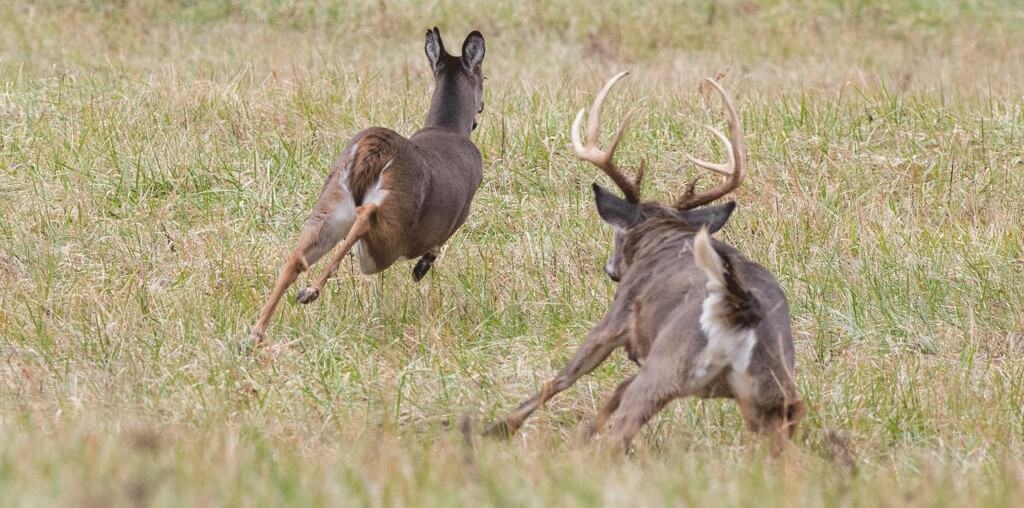
Plus, air temperatures will cool off in the night. So just make sure to consider the temperature of everything, not just the air. If it is in the 60s during the evening and goes down to the 30s at night, you would have more time to find and gut your deer than if it were to only go down to the 50s at night. If your deer was casually walking when you shot it, you would have more time to find and gut it than if it was chasing hard with a higher body temperature.
While all of those things do matter, they are hard to predict. So we have some general rules of thumb. Below is a table of temperatures and the estimated time you have to clean a deer.
| Air Temperature (Fahrenheit) | Time To Process |
| 80+ | 3 Hours |
| 70 – 79 | 4 Hours |
| 60 – 69 | 5 Hours |
| 50 – 59 | 6 Hours |
| 45 – 49 | 7 Hours |
| 40 – 44 | 8 Hours |
| Under 40 | 12 Hours |
I also wanted to mention that we do not necessarily want our deer to freeze either. By the looks of the table above, the lower the temperature, the longer we have to clean a deer, and you would be right. However, if a deer freezes solid, that is not going to be great either.
When a deer freezes, the natural enzymes that break down the meat are completely prohibited, and your end product will be a really tough piece of meat. Plus, a frozen deer is also much harder to skin and quarter, so you will want to track it sooner rather than later if you are braving below freezing temperatures.
If you need a little help tracking your deer, I wrote a whole article about tracking a deer after the shot! You can check it out here, and hopefully, it helps you find your deer before it freezes.
Moisture Is A Slippery Slope
Moisture can also ruin your deer. If it is a really humid day or if it is raining, you will have even less time to gut your deer. Moisture accelerates bacteria growth, and even if you are hunting in a colder temperature, moisture can spoil a deer.
If you have ever had to find a deer the next morning and there was snow on the ground, it is not uncommon for the half of the deer that was on the moist ground to be more discolored than the other half after you skin it. That moisture accelerated the meat deterioration, and it is a good idea to get rid of the entire carcass.
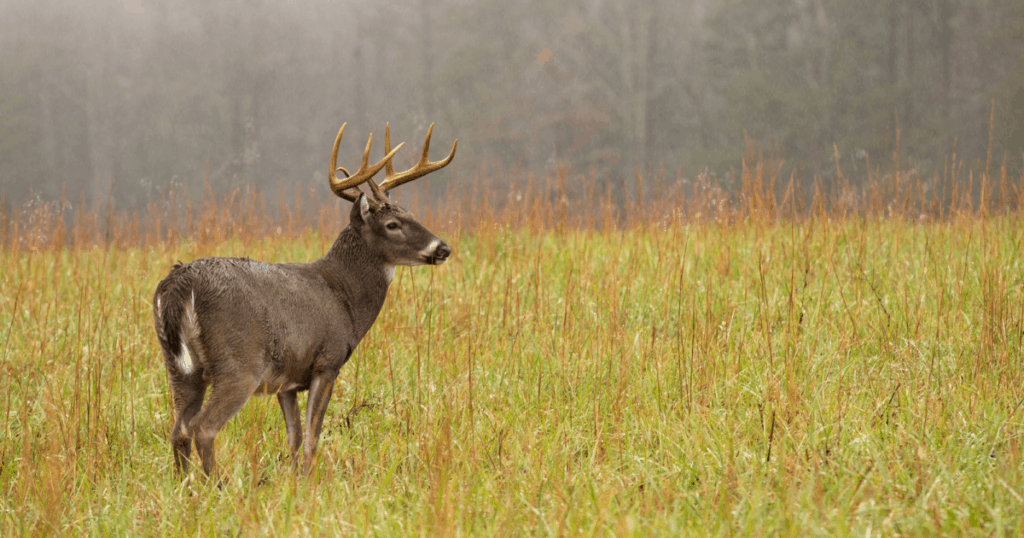
This is the same reason you never want to rinse your deer meat off with a water hose after cleaning it. Making your meat wet will allow even more bacteria to grow, and can lead to a more gamey taste even if you cool it down.
Still Give Your Deer Time
Now that we have established that you should get your deer and gut it as soon as possible, I want to reiterate that you should still be careful and give your deer plenty of time to die. Whenever I shoot a deer, I wait at least 30 minutes before I start to track it, even with a good shot. Even if the deer died where it stood, I am going to wait a while.
Something else you should realize is that your time to gut a deer starts when the deer dies. If your shot takes 2 hours to kill the deer, your recovery time may be 4 hours, but that will only be 2 hours into your processing time. So if you are not sure if you made a fatal shot, and you want to give the deer a little extra time, that is just fine. The difference between these two times is obviously impossible to know, but just knowing there is a difference can calm those nerves a little.
I always suggest tracking a deer at least a few dozen yards on the day you shoot it, unless you are just on a tiny property. A wounded deer will bed down, but if you can get a good sense of direction of where it was going before you pull out, you can get to it quicker when you go back in. Plus, you never know, your shot may be better than you thought and the deer could be 50 yards away dead as a doornail.
I highly suggest still giving your deer plenty of time to die, a wounded animal can be deadly. If you want to know just how deadly a deer can be, read my other article titled “Are Whitetail Deer Dangerous”, hint, YES!
Where Did You Hit It?
As we all know, different types of shots take longer to kill. A heart or lung shot deer will die quicker than a gut shot deer. Although this is another thing we can factor into our processing time. Under the exact same circumstances (temperature, moisture, etc) a deer that is shot in the lungs will last significantly longer without spoiling than a deer that is gut shot.
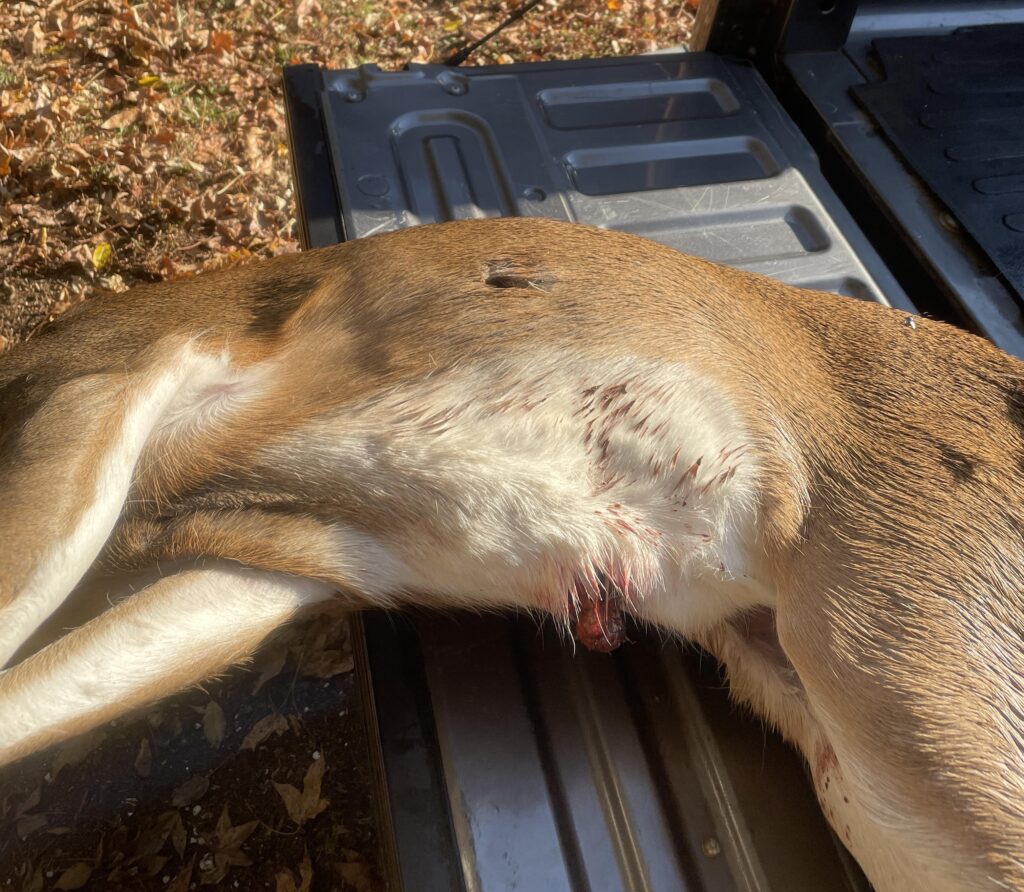
A spoiled carcass is all about bacteria, and the gut is full of bacteria. If you hit a deer in the paunch or gut, you are going to spread a lot of that bacteria around. The tough part is that gut shot deer take a lot longer time to die, and you need to give them a little longer so you don’t bump them.
In general, you can cut your “Time To Process” from the table above in half if you hit your deer in the gut.
If you are not quite sure where you hit your deer, or how long you should wait to recover it, I go into a lot more detail on that subject in this article that I wrote. I highly suggest you check it out!
Can You Eat Deer Meat Left Overnight?
So if you had to pull out and leave your deer overnight, is it still good to eat? Probably not. Can you eat deer left overnight? Yes, and people have done it and continue to do it, but you will not find me doing it. That whole time, bacteria has run wild on your deer, and there is a good chance that other critters have found it too.
If you recover your deer the next morning and it has been chewed on or eaten by any kind of scavenger like vultures, or most commonly coyotes, do not eat it. Take the head and leave the rest. You never ever want to eat after those animals, and just because they bit out of the back leg doesn’t mean you can eat the front leg.
Discarding deer left overnight is just my personal preference. Like I said, some hunters do still eat deer left overnight, and if the temperature is low enough it is feasible. However, there are too many variables there for me to be comfortable, and that weariness is an instinct that has kept humans from catching diseases and parasites for centuries. We are not scavengers, and we certainly don’t eat after them.
How To Tell If Your Deer Is Spoiled
Alright, so if you just ignore everything I have said so far and you are standing over a deer, how can you tell if it is still good to eat? Well, we start with how it looks. If you intend to keep the deer, you can go ahead and gut it and drag it to wherever you are going to skin it. When you get a portion of the skin off and can see the meat, pay attention to its color. If it is discolored, it is bad. Bad meat is usually darker than good meat. So look for dark spots, and if you do find dark sports, I would discard the entire carcass.
An important note is that if you shoot your deer with a rifle, you can get plenty of bloodshot. This will be the meat surrounding where the bullet or arrow directly hit, but it is more apparent with a bullet. Bloodshot also causes discoloration, and it is meat that you should not eat, but it does not warrant throwing the whole carcass away, just the portion that is bloodshot.
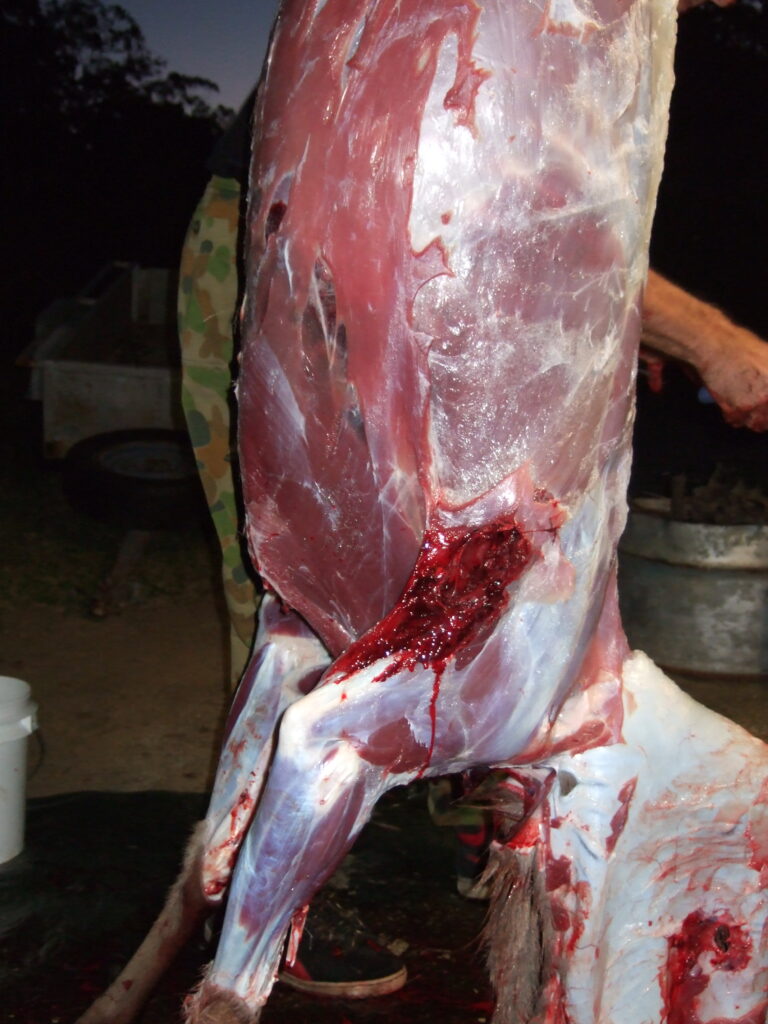
Then, the smell of the deer in general should not be that bad. If it smells bad, it is bad. If it is still good, it should smell like a deer. Next, you want to smell the meat itself. If I am going to salvage a carcass, the first thing I am going to take is a backstrap. So cut the backstrap out and give it a whiff. If it smells like anything other than deer meat and doesn’t make your mouth water and mind dream of a smoker, then it is bad.
It is not a bad idea to make meat color and smell a conscious check before you eat any kind of deer meat, even after it comes out of the freezer. Sometimes meat goes into the freezer good, and comes out bad and can make you sick. If you want to learn what to look for when your meat comes out of the freezer, and keep from getting sick, read this other article I wrote titled “How Long Can Venison Be Frozen?”.
Hustle Up
Long story short, you have a few hours to recover and gut your deer. Although you should gut your deer as soon as possible. Once you find your deer, take a few pictures and get to work. You really need to hustle up and get that deer on ice if you want high quality meat. If it is a little colder out, you have a bit more time to recover your deer, however, no matter what the temperature is, do not wait around to gut and start processing any animal if you have already retrieved it.
Sister Post | How Much Meat You Get From YOUR Deer [Yield Calculator]
A sister post is another post that I have written that follows along with the same topic as the one you just read. After reading this article, you will probably like this next one even more! Here is a little teaser…
Deer hunting is a lot of work early in the season. You have to get your property ready, whether that means planting food plots or clearing a trail. Then you have to pick the right stand location, work your trail cameras, and…Keep Reading
How I Calculated Meat Yield
For starters, we will be working off of field-dressed/gutted deer weight. That is the most accurate method I could find….Keep Reading
How to Get as Much Meat as Possible
If you aren’t the best butcher in the world yet, that’s okay. There is a lot to learn. The first step is…Keep Reading
Thank you for reading my article! I hope you enjoyed it, and if you have any questions or feedback, please send me an email at [email protected]. If you want to learn more about me or Omega Outdoors, visit my About Page. Otherwise, I hope you have a great day, and check out some of my other articles while you’re here!
If you did a quick search on google for how long it takes your deer to spoil, hopefully, these sections will pop up and answer your question. If you want a more exact answer, try reading the section titled “The Main Factor: Temperature” at the beginning of this article.
How Long Does It Take for a Deer to Spoil in 30 Degree Weather
In 30 degree (fahrenheit) weather, you have about 12 hours to gut or field dress a deer. For any deer recovered after that time, you need to seriously inspect it for signs of deterioration. Discoloration, an abnormal smell, and other predation are all valid reasons to discard a deer carcass.
How Long Does It Take for a Deer to Spoil in 40 Degree Weather
In 40 degree (fahrenheit) weather, you have about 8 hours to gut or field dress a deer. For any deer recovered after that time, you need to seriously inspect it for signs of deterioration. Discoloration, an abnormal smell, and other predation are all valid reasons to discard a deer carcass.
How Long Does It Take for a Deer to Spoil in 50 Degree Weather
In 50 degree (fahrenheit) weather, you have about 6 hours to gut or field dress a deer. For any deer recovered after that time, you need to seriously inspect it for signs of deterioration. Discoloration, an abnormal smell, and other predation are all valid reasons to discard a deer carcass.
How Long Does It Take for a Deer to Spoil in 60 Degree Weather
In 60 degree (fahrenheit) weather, you have about 5 hours to gut or field dress a deer. For any deer recovered after that time, you need to seriously inspect it for signs of deterioration. Discoloration, an abnormal smell, and other predation are all valid reasons to discard a deer carcass.
How Long Does It Take for a Deer to Spoil in 65 Degree Weather
In 65 degree (fahrenheit) weather, you have about 5 hours to gut or field dress a deer. For any deer recovered after that time, you need to seriously inspect it for signs of deterioration. Discoloration, an abnormal smell, and other predation are all valid reasons to discard a deer carcass.
How Long Does It Take for a Deer to Spoil in 70 Degree Weather
In 70 degree (fahrenheit) weather, you have about 4 hours to gut or field dress a deer. For any deer recovered after that time, you need to seriously inspect it for signs of deterioration. Discoloration, an abnormal smell, and other predation are all valid reasons to discard a deer carcass.
How Long Does It Take for a Deer to Spoil in 75 Degree Weather
In 75 degree (fahrenheit) weather, you have about 4 hours to gut or field dress a deer. For any deer recovered after that time, you need to seriously inspect it for signs of deterioration. Discoloration, an abnormal smell, and other predation are all valid reasons to discard a deer carcass.
How Long Does It Take for a Deer to Spoil in 80 Degree Weather
In 80 degree (fahrenheit) weather, you have about 3 hours to gut or field dress a deer. For any deer recovered after that time, you need to seriously inspect it for signs of deterioration. Discoloration, an abnormal smell, and other predation are all valid reasons to discard a deer carcass.
Legal Disclaimer: All information in this article is for entertainment purposes only. Omega Outdoors LLC is not liable for any sickness that results from a reader consuming spoiled meat.

